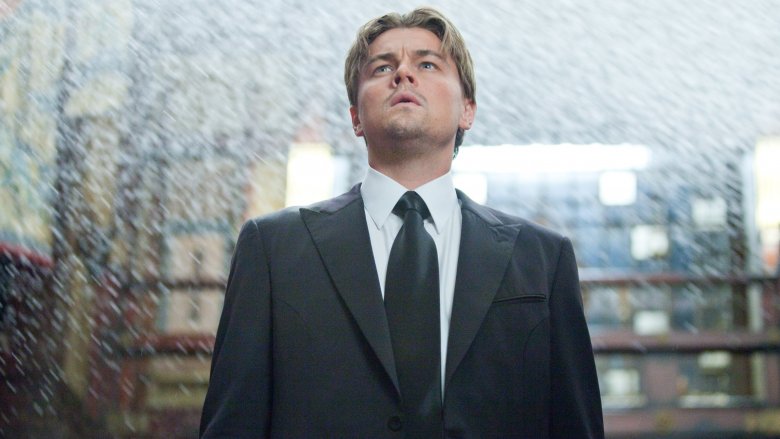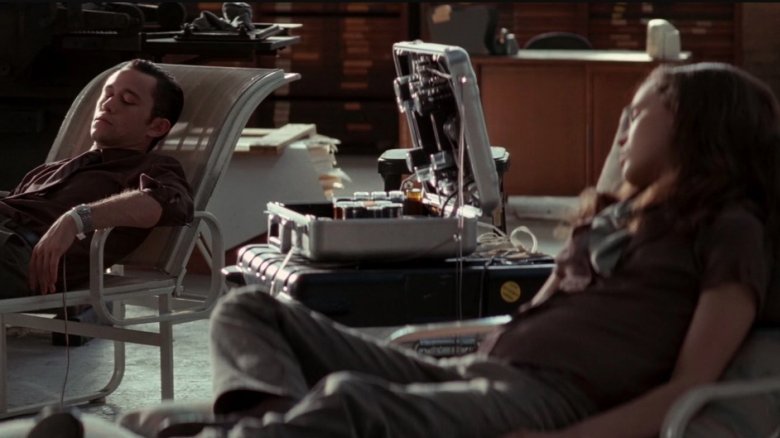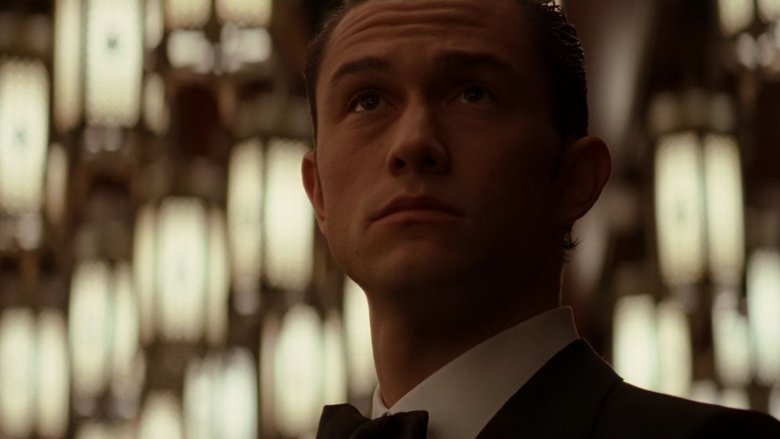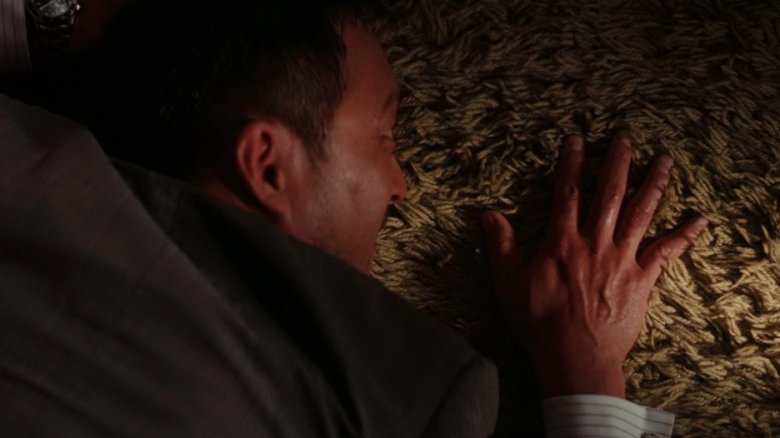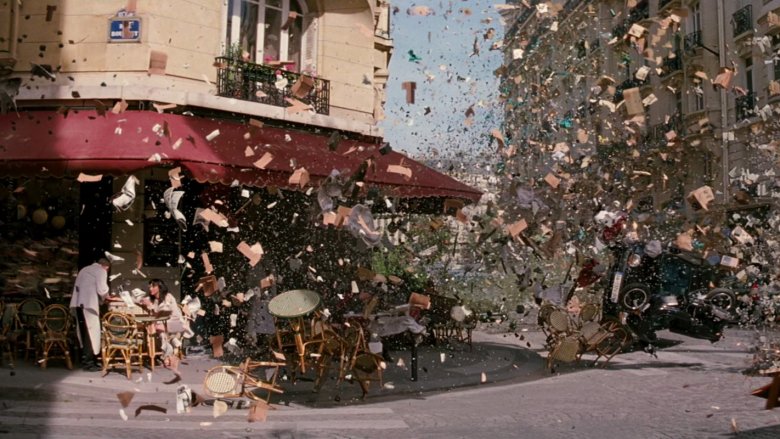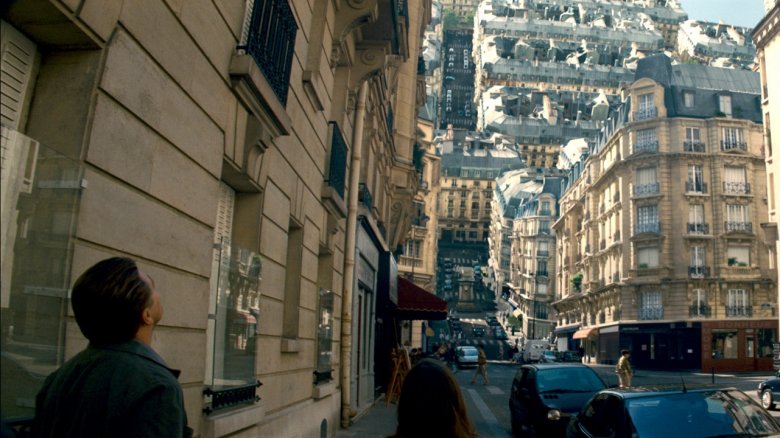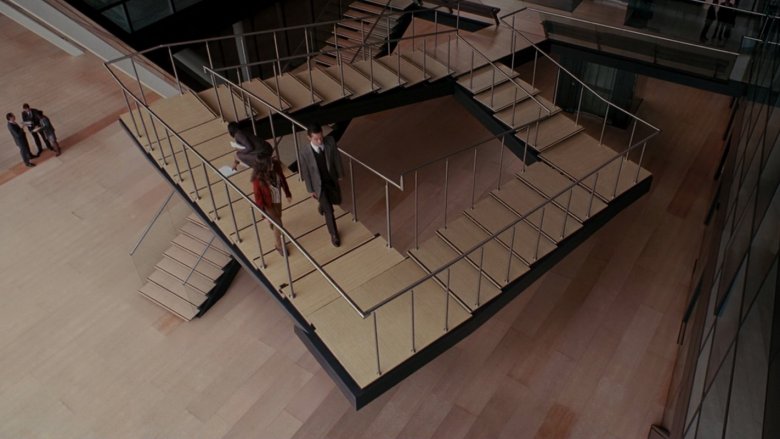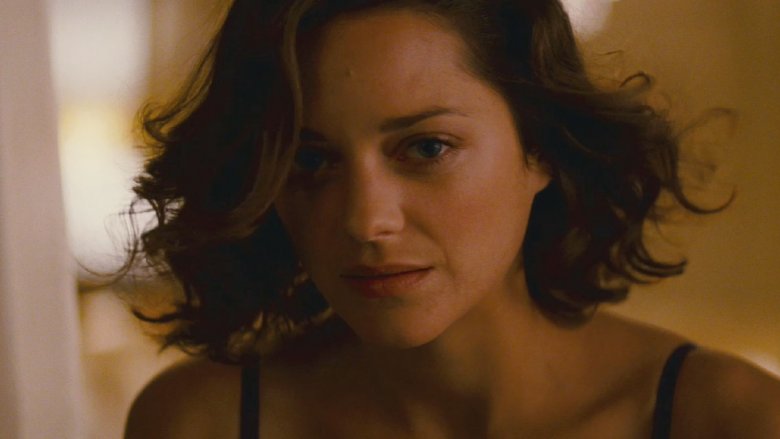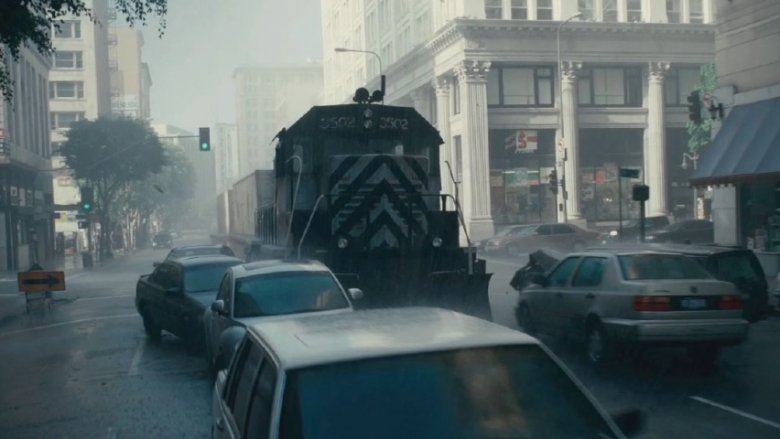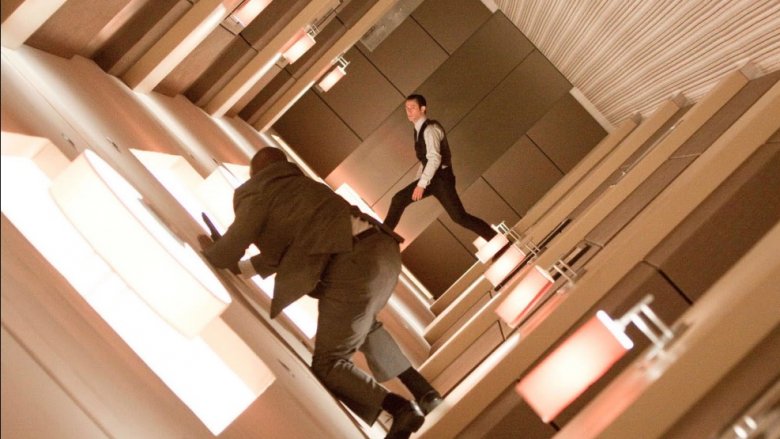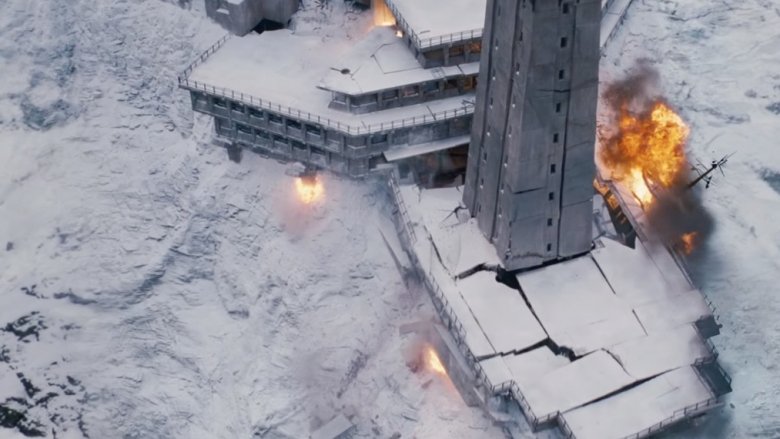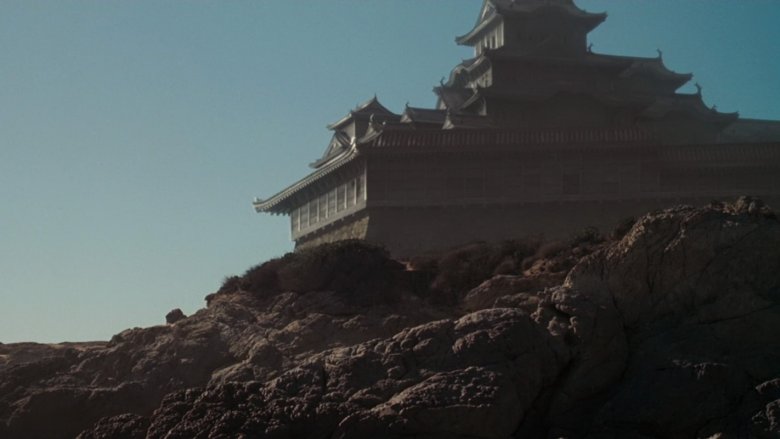The Dream Sequences In Inception Explained
Dreams don't exactly make logical sense. Unless you've got plenty of time to browse dream meaning sites, you're generally going to wake up completely clueless about what your subconscious was up to while you were sleeping. Luckily, when it comes to deciphering dream sequences in movies, well, that's a whole lot easier.
Of course, some cinematic dreams are tougher to crack than others, like all the mind-bending visions in Inception. Christopher Nolan's dream-heist film tells the story of thieves who gain access to subconscious worlds that hide very clear reflections of the dreamer's fears, desires, and anxieties. While the movie might've gained a slightly unfair reputation for being hard to understand, we don't blame anyone for getting a little confused at what all the various dream layers mean.
So today, we're going to grab our totems, cue up "Non, Je Ne Regrette Rien", and break down what's real, what's a dream, and what it all means for our group of sneaky dream thieves. From hallway fights to getting lost in limbo, here are the dream sequences in Inception explained.
What is the Inception technology?
Inception takes place in a world that seems pretty similar to our own, dream-sharing technology aside. But what's the story behind that tech? Well, as Arthur (Joseph Gordon-Levitt) tells Ariadne (Elliot Page) early in the film, the dream-sharing technology was developed by the military in order to facilitate a training program for soldiers in which they could practice killing each other without consequences. From there, the technology spread out to the underground, where Cobb (Leonardo DiCaprio) and his team use it for extraction, a process where they can steal a target's secrets buried in their subconscious. In addition to extraction, there's also inception, a technique in which an idea is implanted in the target's subconscious in order to make the dreamer believe that the idea is their own.
At each level of shared dreaming, there has to be a dreamer and a subject. The dreamer builds the world, while the subject populates it with projections — subconscious thoughts that tear apart any dream intruders if the intruder's presence is recognized. In addition, subjects are usually the target for the heists in Inception. They're the ones whose subconscious is on display and are most susceptible to dream thieves. During Inception's heist scenes, nearly every member of Cobb's team functions as the dreamer, while Fischer (Cillian Murphy) remains the consistent subject.
Of course, there are other important roles in the dream heist. For example, there's Ariadne as the architect, someone who builds in dream layer mazes to make it more difficult for Fischer's subconscious to recognize the intruders. There's Yusuf (Dileep Rao) as the chemist, who's charged with creating a specific mixture of sedatives in order to keep Fischer unconscious long enough for the inception to work. And finally, Eames (Tom Hardy) makes his paycheck as the forger, someone able to impersonate people within the dream world.
The Japanese castle is Arthur's dream within a dream
So let's start our Inception analysis with the second dream sequence we see in the film (we'll get to the first later). This one takes place in Saito's (Ken Watanabe) Japanese castle. Cobb and Arthur have gone into Saito's subconscious in order to steal specific secrets hidden in Saito's mind on behalf of Cobol Engineering, a rival company to Saito's Proclus Global. In the castle, Saito keeps his most important secrets in a hidden safe.
Cobb finds his way in there, but during the heist, Arthur is captured by Cobb's wife, Mal (Marion Cotillard). Okay, technically, she's a projection of Cobb's subconscious and a reflection of the guilt that Cobb feels for his part in his wife's death. Mal works with Saito, threatening to torture Arthur, but Cobb shoots his buddy in the head first, which begins to end the dream. With Arthur dead (i.e. awake), the dream begins to collapse, which makes Arthur the dreamer for the Japanese castle. Saito, the subject, is killed by falling rubble, causing him to wake up from the castle dream, while Cobb is pushed into a bathtub full of water in order to forcibly kick him out of the castle dream space.
The apartment is Nash's dream
After Cobb, Arthur, and Saito wake up from their little castle adventure, they find themselves in Saito's secret apartment. At first, we think they're back in the real world, but nope, this is the original dream. The castle was the second level of the dream, and Saito's apartment is the first level, where the architect Nash (Lukas Haas) has created a replica of Saito's real-life love nest.
So just like the castle dream, Saito remains the subject. But while Arthur was the dreamer of the castle (which is destroyed after he wakes up), Nash is the dreamer of the apartment. And things get pretty tense once Saito figures out he's being conned by a bunch of dream thieves. He attacks Arthur and Nash, but Cobb gets the drop on him, interrogating Saito for information. As it turns out, Saito's secrets in the second level of the dream weren't completely available to Cobb, so he threatens Saito, trying to get him to reveal the info by force.
However, that's when Saito realizes these dream thieves are really good at their jobs. Since Nash designed this apartment to mirror Saito's secret getaway, the businessman is totally fooled at first ... until he touches the carpet. That's when he recognizes the carpeting is made of polyester instead of wool, like at his actual pad. With the knowledge that he's still dreaming, Saito's subconscious projections flood the room as angry rioters, killing the dream thieves and waking them up for real.
The Parisian cafe in Inception is Cobb's dream
As it turns out, Saito was the mastermind behind the film's first dream heist. He secretly hired Cobb and his crew to infiltrate his own subconscious. It was sort of a trial run. He wanted to see how good these guys were. And now that he's impressed, he offers Cobb a job, asking if his team will perform inception on Robert Fischer, the heir of a rival conglomerate.
After accepting the job, Cobb meets up with Miles (Michael Caine), his former teacher and father-in-law, to see if there's an architect talented enough to make it work. Miles sends him Ariadne, who, after a brief maze-drawing test, meets Cobb's approval. At some point in their conversation, they wind up in a Parisian cafe, where Cobb shares an important aspect of dream sharing: When you're dreaming, you don't remember how you entered a location. The subject starts the dream during the action, with no build-up to what's actually happening. Cobb reveals to Ariadne that she's dreaming in order to show how easy it is to trick the subject into believing that a dream is reality. So if we want to get technical here, in the cafe, Ariadne is the subject, while Cobb is the dreamer. Once Ariadne realizes she's in a dream, she panics, and it starts to collapse, waking both of them up.
The Parisian street is Ariadne's dream
After their visit to the imaginary cafe, Cobb and Ariadne head back into the dream world, but this time, Cobb is the subject. As the dreamer, Ariadne has full control over the reality of the dream and impresses Cobb by constructing a replica of the last dream's location. However, Cobb warns her that if his subconscious projections perceive her to be an intruder, they'll attack. Ariadne experiments with dream logic, folding over architecture and building the world of the dream around them as they walk. When Ariadne begins to construct actual architecture from real life, Cobb warns her away from the habit. He tells her that if she consistently uses whole subjects directly from real life, it can complicate the relationship a dreamer has to reality. It becomes nearly impossible to tell what's real if your dreams look and feel just like reality.
Luckily, there's a solution, which involves using a totem, a physical object that functions in a unique way that a dream thief wouldn't be able to replicate. (Cobb's totem is a top that stops spinning when he's in the real world, Arthur uses a weighted die, and Ariadne eventually builds a hollowed-out bishop chess piece.) Within the dream in Paris, Ariadne's physics-bending experiments lead to Cobb's subconscious attacking her. Imaginary Mal pops up once again and delivers the killing blow by stabbing Ariadne in the stomach, waking her up.
The lobby with the Penrose stairs is Arthur's dream
Soon, Ariadne gets a crash course in building dream levels with Arthur, who takes her into a dream level of his own design. Here, Arthur is the dreamer while Ariadne is the subject, since Arthur's the one controlling the architecture. In what looks to be an office building, Arthur shows Ariadne how dreamers can adjust architecture to make things that would be impossible in the real world. Arthur borrows an example from an impossible object created by Lionel and Roger Penrose, later popularized by M.C. Escher, in which a staircase constantly ascends in a looping circle.
Ariadne mentions that her subconscious doesn't seem to be acting violent towards Arthur yet, but Arthur reveals that she has no real control over their response to his presence. If her subconscious perceives him to be a threat, they'll attack him, even if Ariadne doesn't want them to.
In dreams, Arthur explains, you can trick geography around the subject, creating shortcuts and dead ends to help with dream mazes. With closed loops and confusing geography, the dreamers can exist within the subject's mind long enough to do what they need to do before getting torn apart by the projections. Arthur also reveals that Cobb doesn't build dream layouts anymore, out of fear that if he knows the layout of the dream, so will his subconscious projection of Mal.
The apartment of memories is Cobb's dream
Ariadne learns even more about Cobb's complicated relationship to his subconscious projection of Mal when she enters his dream late at night. It turns out that Cobb has been using the shared dreaming device to help him dream, since repeated exposure to the machine means that he can no longer naturally dream.
In this particular dream, Cobb is both dreamer and subject, while Ariadne is only an interloper exploring his memories. She has no control over the geography, while Cobb has filled his own dream with projections. Specifically, Cobb has built multiple levels of a building, each filled with his time with Mal and each representing a different moment that he wants to relive, or in some cases, that he wants to change.
In the real world, Mal killed herself while framing Cobb for her murder, making it impossible for him to return to America to be with his children. After finding out how deeply Mal is buried in Cobb's subconscious, Ariadne insists on accompanying the team into Fischer's dream, rather than just being the architect behind it. Only she understands how dangerous Mal, and by extension Cobb, can be.
The rainy city is Yusuf's dream
With Saito along for the ride, Cobb assembles his crew to perform inception on Fischer during the flight from Sydney, Australia, to Los Angeles. The goal is to incept within Fischer the desire to break up his father's business empire, which will keep Fischer from destroying Saito's own company. In return, Saito will use his influence to clear Cobb's murder charge, letting him return home.
When the crew finally starts the heist, they end up in a rainy city. In this dream, Yusuf is the dreamer, following a design created by Ariadne, while Fischer is the subject. The team kidnaps Fischer, but his subconscious has been trained to resist, which means that his projections are highly trained and weaponized.
Cobb also reveals a key detail that he kept from his team. In order to incept Fischer, they need to go down three dream levels ... which means that Yusuf added a heavy sedative that's changed the stakes. Instead of waking up when they die in the dream, anyone fatally wounded is sent down to limbo, pure subconscious dreamscape, where they might never escape. (That's bad news for Saito, who's wounded when they initially grab Fischer.)
Soon, Eames disguises himself as Peter Browning (Tom Berenger), Fischer's godfather, in order to spark the idea that Fischer's dad wanted his son to destroy the empire. Then Cobb and his team, disguised as kidnappers, throw Fischer into a van driven by Yusuf. Once he's in, they send the team, minus Yusuf, into the second dream layer. On the first level, Yusuf will drive the van away from the attacking subconscious projections, timing out the "kick" meant to knock everyone back up to the next dream level with a musical cue. And yeah, it doesn't help matters when a train randomly shows up in the middle of the street, courtesy of Cobb's unstable subconscious.
The hotel is Arthur's dream within a dream
Within the hotel, Saito has a bit more time before he dies, since each dream level gives the team 20 times the length of the previous layer. But because of Fischer's increased subconscious protection, Cobb opts for a risky plan. He's going to tell Fischer that he's in a dream, but that Cobb, going by Mr. Charles, is an implanted projection meant to protect Fischer. In effect, the gambit is meant to trick Fischer into joining the heist on his own mind. Of course, Fischer's projections will still attack the team, since his own belief that Cobb is on his side doesn't extend to his subconscious projections. Still, the gambit works, and Fischer and Cobb head to a hotel room where they confront Fischer's subconscious projection of Browning.
Fischer believes that his subconscious projection of his godfather is the Browning (who was actually Eames in disguise) that he met on the first dream level — which he now believes to be reality. Simple, right? The team convinces Fischer to use shared dreaming to go into Browning's mind to see if the man is hiding anything from Fischer, but that's just a trick meant to disguise the fact that the team is actually heading into Fischer's third dream level. Meanwhile, the hotel is Arthur's dream, so he's required to stay behind to fight projections and provide the kick by blasting the floor out from under the dreaming team.
The snowy mountain is Eames' dream within a dream within a dream
In the third layer of the dream, the team winds up on a snowy mountain. Saito is to bring Fischer into a safe inside a fortress where they can permanently incept the idea, while Eames, Cobb, and Ariadne provide cover and a distraction. On the mountain, Eames is the dreamer, while Fischer remains the subject, even if he doesn't realize that fact.
Unfortunately, even with the extra time from the deeper dream levels, Saito is dying, and the entire operation is running out of time. Ariadne reveals a shortcut that she built into the dream with Eames, and the team is able to get Fischer inside within the time limit. However, by telling Cobb about the shortcut, that also means that Mal knows about the shortcut, and she arrives just in time to shoot Fischer, trapping him in limbo.
With their goal in sight, Cobb and Ariadne come up with a Hail Mary idea. They'll dive into limbo to kick Fischer back up to level three just long enough for him to incept the idea into his own brain. Then, in a coordinated triple-kick, Eames, Arthur, and Yusuf will send the team all the way back to the first dream level.
Limbo is everyone's dream within a dream within a dream within a dream
In limbo, Cobb shows Ariadne the city that he built with Mal when they were both trapped in limbo for decades. Because limbo is pure subconscious space, there's no actual dreamer that builds the geography, although the landscape remains consistent with Cobb's experience in limbo because he's the only member of the team that's been there before. Basically, since no one else can imagine what it would look like, Cobb's version of limbo becomes everyone's conception of limbo.
In limbo, Mal is holding Fischer hostage, trying to use him as a bargaining chip to force Cobb to stay with her. Since Mal is also Cobb's subconscious, it's a reflection of Cobb's own desire to stay in limbo with a simulacrum of the family that he no longer has. Cobb manages to accept his own guilt in Mal's death, since he was the one who incepted the idea in her mind that her world wasn't real in order for the two to originally escape from limbo. However, that idea remained in her brain even once they escaped, making Cobb partially responsible for Mal's own death, as she committed suicide in the real world, thinking she'd wake back up. In a sense, Cobb really did murder her.
With all that drama going on, Ariadne sends Fischer back up to the third level, where he's able to unintentionally incept himself to break up his father's empire. Cobb stays behind to look for Saito, whose death on the higher level means that he's stuck somewhere in limbo, while Ariadne rides the kicks all the way back up to the first dream level.
Cobb and Saito's shared limbo is Inception's final dream ... maybe
The scene that opens Inception — the first few seconds with Cobb on a beach — is the never-ending world of limbo. At the end of the film, we return to that in media res moment to find Saito completely lost. Having died in a previous dream level, he's stuck in limbo and has recreated the Japanese castle seen earlier in the film. He's also aged decades in the intervening years while only moments have passed on the upper dream levels. Because Saito fell into limbo unconsciously, he's lived decades under the impression that limbo is reality before Cobb is able to rescue him.
When Cobb finally does find him, after washing up on the shore of Saito's castle, he tries to convince Saito that limbo is not reality. He's able to remind Saito of their shared goal, telling Saito, "Come back, so we can be young men together again." The scene ends with Cobb reaching for his gun, presumably to shoot Saito and himself, to send the two back up to the waking world.
But does he actually succeed? The last moments of the film are arguably the most dream-like of the film, showing Cobb and his team moving through LAX, having fully succeeded at convincing Fischer to give up his empire. Cobb is no longer a wanted man, with Saito's intervention somehow allowing him to pass through immigration without a second thought. When he arrives home, Cobb spins the top totem he uses to check if he's in reality, but he ultimately walks away without checking to see what it reveals. Whether or not the final scene of Inception is actually limbo, Cobb has accepted it as reality.
